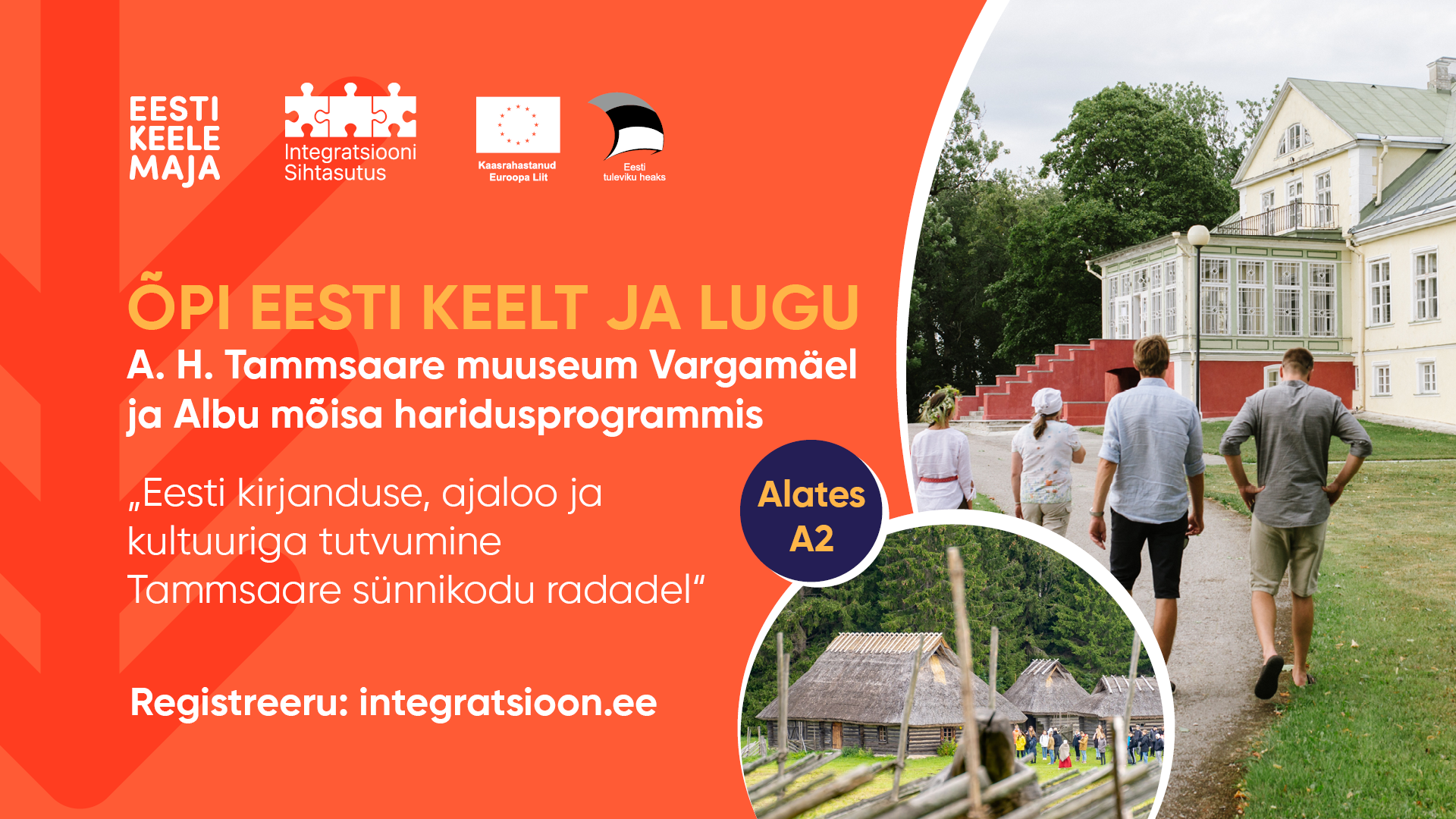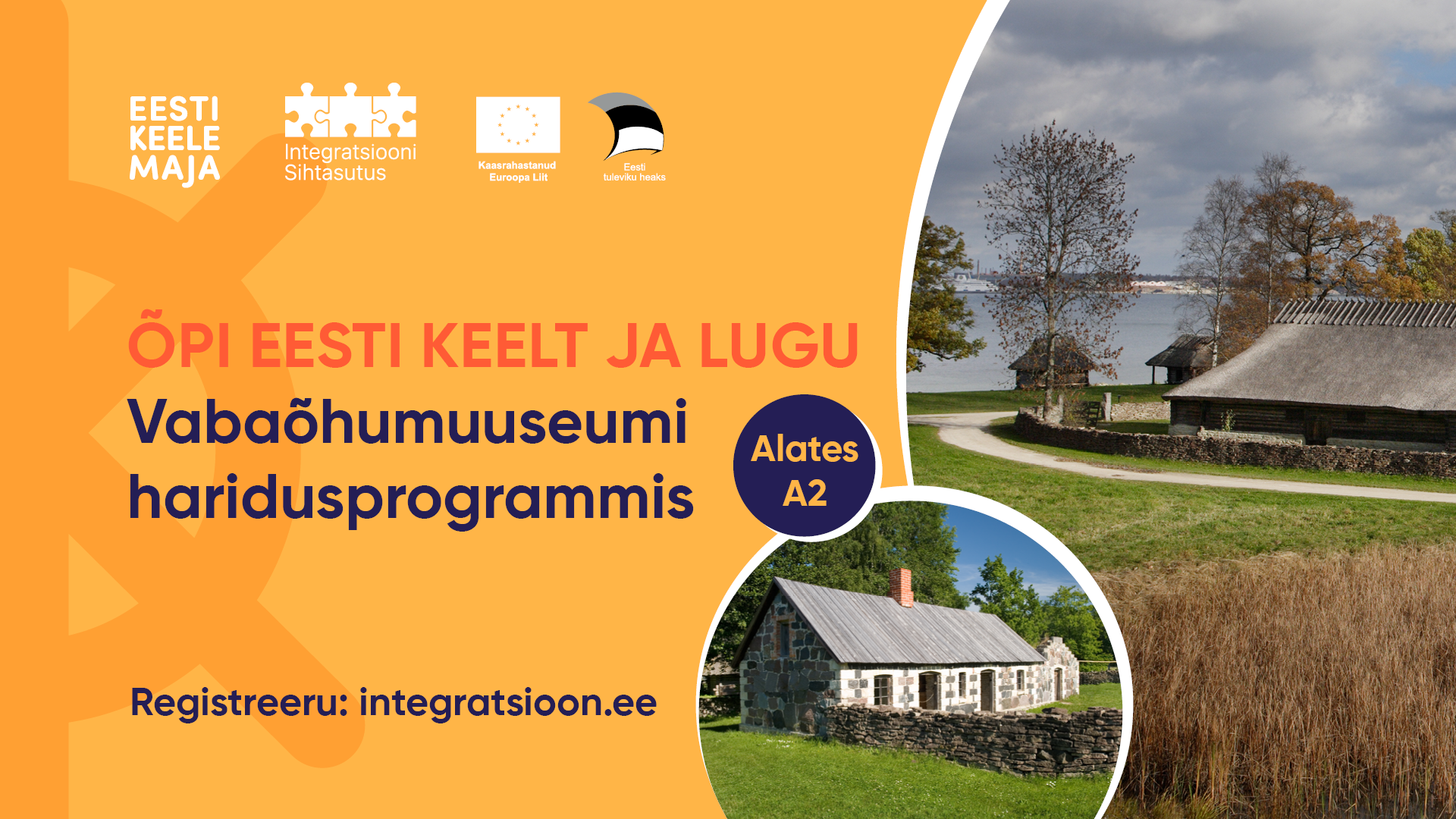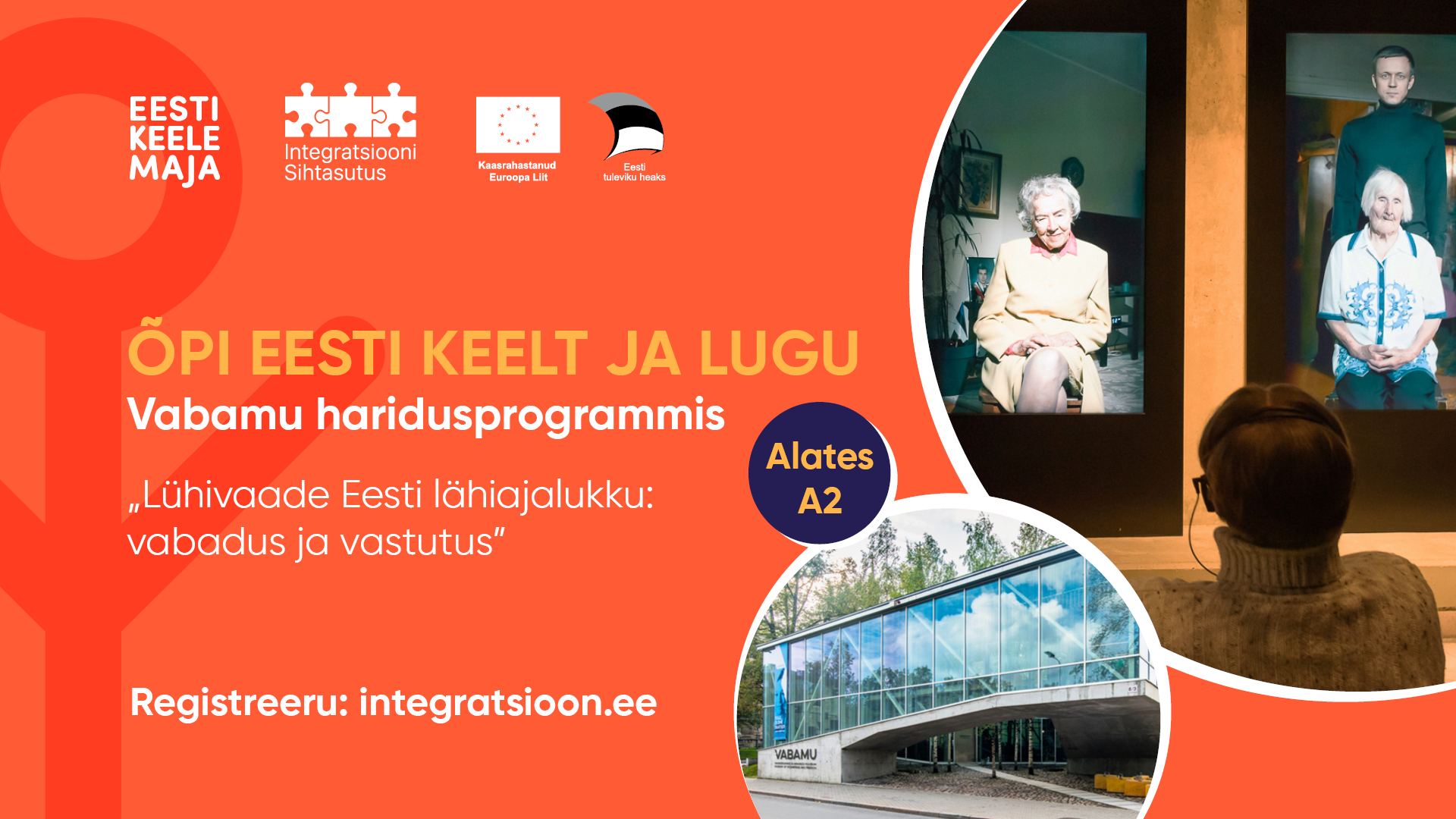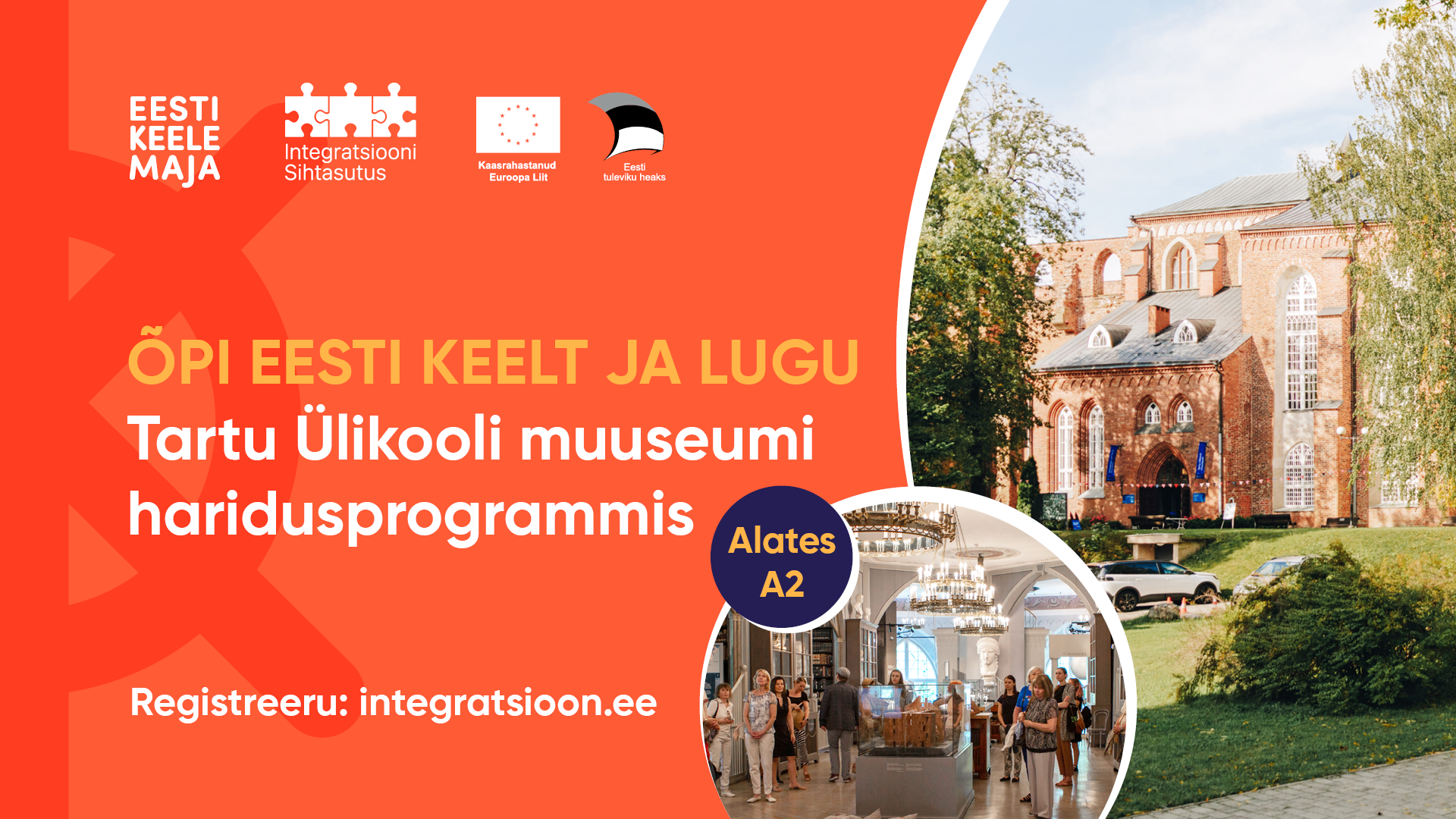From 9 April, Estonian language learners are welcome to sign up for free educational programmes on cultural diversity, now offered by Vabamu, Estonian Police Museum, TYPA Printing and Paper Art Centre, Narva Museum, and A. H. Tammsaare Museum in Vargamäe, in addition to the Estonian Open Air Museum and the University of Tartu Museum.
Museums in Tallinn, Tartu, Narva, Rakvere, and Järva County run educational programmes in simple Estonian to support adults with limited language skills in learning and practising Estonian. The aim is to support beginners in their efforts to understand Estonian through listening and reading tasks, and to encourage them to communicate with each other through simple group activities. In this way, the educational programmes encourage people to continue learning languages.
Language learners can participate in the educational programme of the Estonian Open Air Museum and the University of Tartu Museum free of charge until December 2024, and in the educational programmes of the other five museums until February 2025. You can choose the programme by theme as well as by date. Each group consists of 10–20 language learners from all over Estonia.
For detailed information on the programme of interest and to sign up, visit our foundation’s online self-service portal, which can be accessed via this link.
A.H. TAMMSAARE MUSEUM IN VARGAMÄE (Järva rural municipality)

A. H. Tammsaare Museum in Vargamäe (Vetepere village, Järva rural municipality) holds an educational programme once a month on a Saturday at 10.30 a.m. to 3.00 p.m. in Vargamäe and Albu Manor (the programme includes the bus ride from Vargamäe Museum to Albu Manor). In the educational programme ‘Eesti kirjanduse, ajaloo ja kultuuriga tutvumine Tammsaare sünnikodu radadel’ (Exploring Estonian literature, history, and culture on the paths of Tammsaare’s birthplace), we will introduce 18th–19th century farm life through Estonian literary classics, discussing the works of writers A. H. Tammsaare and Eduard Vilde.
Activities are built around listening, writing, communication, hands-on, and physical activities. The programme provides an opportunity for Estonian language learners to stay in an environment that is significant in Estonian cultural history and actively acquire new knowledge in this environment. On the museum and manor tour, we will find out why the Tammsaare Museum in Vargamäe is an important place and how it is connected to Albu Manor. We will familiarise ourselves with life on a farm and life in a manor, learn vocabulary related to self-introduction, everyday life, home, and family.
NARVA MUSEUM (Narva)

Two educational programmes will take place at the Narva Museum:
‘Narva – jõgi ja linn’ (Narva – the river and the city) at Narva Castle (Peetri plats 7, Narva) on Thursdays at 5.30–7.45 p.m.
We explore the impact that the widest and deepest river of Estonia has had on the development of the region and the city. We dive into the distant past, when the waterways running through the city were bustling with trade, and find out what sold best. We talk about how people have used the river over time and the impact it has had on the river.
‘Narva arhitektuuripärand’ (The architectural heritage of Narva) at Narva Museum Art Gallery (Vestervalli 21, Narva) on Saturdays at 11.00 a.m. to 1.15 p.m.
The programme will be held at the permanent exhibition the scale model of Old Narva. Exploring the model of the city will give you a chance to immerse yourself in the atmosphere of the pre-war city, discover its architectural characteristics and explore a variety of architectural styles. The programme will draw parallels with the modern Narva, discuss the changes in the lives of the city’s residents, depending on the conditions of the city’s development.
ESTONIAN POLICE MUSEUM (Rakvere)
The educational programme of the Estonian Police Museum (Tallinna 3, Rakvere) takes place twice a month on Mondays at 5.15–7.45 p.m. The educational programme ‘Turvaliselt Eestis’ (Safe in Estonia) introduces the functioning of the Estonian police and through this the values that underpin Estonian society.
Through hands-on and interactive activities in the exhibition and outdoor area of the Police Museum, participants will acquire simple vocabulary related to internal security and traffic. Through different activities, participants will learn about police work and the basics of travelling safely in traffic. The group will discover different aspects of police work, including traffic police, riot police, constabulary, and more. The programme includes important terms and phrases related to road safety and general security. You will also learn about the traffic rules and signs in Estonia.
The educational programme conveys the core safety messages and values of the police – humanity, cooperation, safety, professionalism, trustworthiness, openness, honesty, and people-centric approach. Through these values, participants also gain a better understanding of the principles of a democratic country. Participants act out a situation on how to call the emergency services. In the outdoor area of the Police Museum courtyard, participants will be able to get to know different vehicles (a border guard boat, different police cars, a water cannon). As a result of the educational programme, participants will gain a better understanding of how Estonian society and institutions related to internal security work. The programme will also help to ensure safe behaviour for oneself and others in everyday life in the new language environment.
ESTONIAN OPEN AIR MUSEUM (Tallinn)

The Estonian Open Air Museum invites you to participate in the educational programme ‘Eestlaste eluolu pärisorjusest taasiseseisvumiseni’ (The life of Estonians from serfdom to the restoration of independence), the description of which is available here.
VABAMU MUSEUM OF OCCUPATIONS AND FREEDOM (Tallinn)

The educational programme of the Vabamu Museum of Occupations and Freedom (Toompea 8b, Tallinn) takes place once a month on a Saturday from 10.00 a.m. to 3.00 p.m. The value-based educational programme ‘Lühivaade Eesti lähiajalukku: vabadus ja vastutus’ (A brief look at the recent history of Estonia: freedom and responsibility) will also include a visit to the KGB Prison Cells (Pagari 1, Tallinn).
The programme will start at Toompea 8b and from there the group will walk together to the KGB Prison Cells at Pagari 1. Through memories and personal stories, we will learn about the lives of Estonians and consequently discuss the role of the individual in society through the twists and turns of Estonian history. We will look at the choices that that people are forced to make due to wars and social change, how to remain true to oneself in difficult situations, how to fight injustice, and the impact that civic initiative and courage can have. The educational programme also uses active learning techniques to discuss human rights and freedoms, and uses a timeline and pictures to locate the most important events in the recent history of Estonia.
Participants will visit Vabamu theme rooms
This will be followed by a tour of the KGB Prison Cells, where there will be a fourth exhibition visit focusing on the themes of a recollection environment, remembering, and remembrance, followed by a creative group work activity and a concluding discussion.
UNIVERSITY OF TARTU MUSEUM (Tartu)

The University of Tartu Museum is looking forward to the educational programme ‘Tee teadmisteni Eesti kultuurist ja pärandist rahvusvahelises rahvusülikoolis’ (The path to knowledge of Estonian culture and heritage in an international national university), the description of which can be found here.
TYPA PRINTING AND PAPER ART CENTRE (Tartu)
The educational programme of the TYPA Printing and Paper Art Centre (Kastani 48f, Tartu) takes place twice a month on Thursdays from 5.30–7.45 p.m. The theme of the educational programme ‘Silmapilk ja sõnajada’ (A blink and a string of words) is visual and literary motifs in Estonian culture, celebrating the diverse and distinctive artistic history of Estonia, but also seeking common ground with other cultures.
The aim of the educational programme is to introduce Estonian visual and literary culture through a variety of hands-on and artistic activities, while at the same time providing an opportunity to improve your Estonian language skills through discussion, writing and listening. The programme is divided into 13 thematic blocks, which allows participants to explore Estonian art, literature and culture through graphic art, printing, paper art, and binding, and is therefore primarily art-centred. As a result of the programme, the participant will be better oriented in Estonian culture and language and will be able to use the most common graphic techniques, make paper art and bind simple books.
* The educational programme is funded by the ESF+ project No. 2021-2027.4.07.23-0006 ‘Activities supporting Estonian language learning and civic education’, sub-activity No. 3.4.4.3 ‘Creation of educational programmes, including in simple Estonian, in cultural and sports institutions’.
